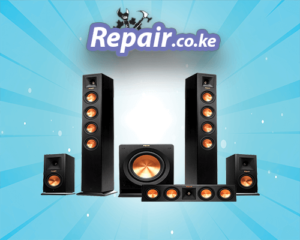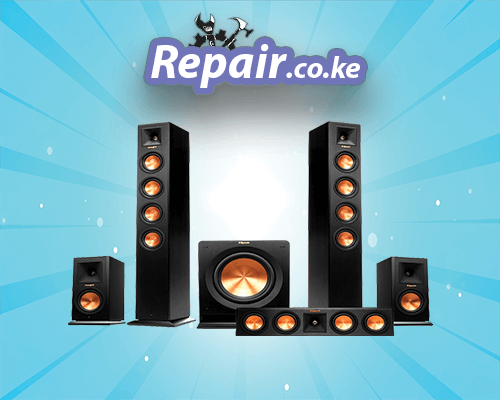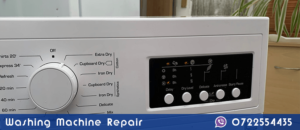Home Theater Repair in Nairobi Kenya
Get the best home theater repair in Nairobi by the best Electronic appliances repair technicians. Home theater repair refers to the process of diagnosing and fixing issues or malfunctions in home theater systems and related audio-visual equipment. These systems typically consist of components such as audio receivers, speakers, subwoofers, amplifiers, televisions, projectors, Blu-ray players, and various audio and video cables. When these components develop problems or fail to function correctly, homeowners may seek the expertise of technicians or repair professionals to identify and rectify the issues.
Common reasons for home theater repair include:
- Audio Problems: This may include issues such as no sound, distorted audio, or unbalanced sound. It can result from problems with speakers, cables, amplifiers, or the audio receiver.
- Video Issues: Problems with the video may involve distorted or no picture, color abnormalities, or resolution problems. These could be related to the television or projector, video cables, or the AV receiver.
- Connectivity and Wiring Problems: Home theaters often involve a complex network of audio and video cables. Connectivity issues may lead to signal loss, interruptions, or a lack of communication between components.
- Software and Firmware Problems: Software-related issues might involve problems with the settings, configuration, or the need for firmware updates to ensure proper functioning.
- Remote Control Problems: Malfunctions with remote controls can disrupt the ease of use and control of the home theater system.
- Overheating or Ventilation Issues: Home theater components can overheat, which can lead to reduced performance or even damage. Ensuring proper ventilation and cooling is essential.
To perform home theater repair, technicians may:
- Diagnose the issue by testing each component and identifying the root cause of the problem.
- Replace or repair faulty parts or components, such as speakers, amplifiers, cables, or circuit boards.
- Update software or firmware to resolve software-related issues.
- Ensure proper calibration and configuration of audio and video settings.
- Offer maintenance recommendations to prevent future problems.
Ultimately, the goal of home theater repair is to restore the system to its optimal working condition, providing homeowners with an immersive and high-quality audio-visual experience. In some cases, depending on the complexity of the issue or the need for replacement parts, the repair may be performed by a professional technician or service provider.
Home Theater Repair in Nairobi for all common Home Theatre Problems
Home theater systems provide immersive entertainment experiences, but like any electronic equipment, they can encounter various issues. Here are some common problems with home theater systems and their repair solutions:
- No Sound or Audio Issues:
- Common Causes: This problem can result from loose or disconnected cables, incorrect settings on the AV receiver, or a malfunctioning amplifier.
- Repair Solutions: Check all cable connections to ensure they are secure. Verify that the AV receiver is set to the correct input source and that the speakers are properly configured. If the issue persists, it could be a problem with the amplifier or the AV receiver, which may require professional repair or replacement.
- Video Problems:
- Common Causes: Video issues can be caused by loose or damaged HDMI or other video cables, misconfigured display settings, or problems with the source device (e.g., Blu-ray player, gaming console).
- Repair Solutions: Check all video connections, ensuring that HDMI or other video cables are in good condition and properly connected. Verify the display settings on your AV receiver and source device. If the problem is with the source device, consult the device’s manual or seek manufacturer support. If it’s an AV receiver issue, professional repair may be necessary.
- Remote Control Problems:
- Common Causes: Remote control issues may result from drained or damaged batteries, a blocked remote sensor on the AV receiver, or a malfunctioning remote.
- Repair Solutions: Start by replacing the remote control batteries. Ensure there are no obstructions between the remote control and the AV receiver’s sensor. If the remote control is still not working, it might need repair or replacement.
- Speaker Problems (e.g., Distorted Sound, No Sound):
- Common Causes: Speaker issues can occur due to loose speaker wire connections, damaged speakers, or problems with the AV receiver.
- Repair Solutions: Examine all speaker wire connections, ensuring they are securely attached to the AV receiver and speakers. If a speaker is producing distorted sound, it could be damaged and may require replacement. Test the speaker with a different channel on the AV receiver to verify the source of the problem. If the AV receiver is at fault, consult a technician for repair.
- Subwoofer Not Working:
- Common Causes: Subwoofer problems can arise from loose or disconnected subwoofer cables, incorrect subwoofer settings, or a malfunctioning subwoofer.
- Repair Solutions: Check subwoofer connections to ensure they are properly plugged in. Verify the subwoofer settings on the AV receiver and make sure it’s set to “On” or “Auto.” If the subwoofer remains non-functional, it might be a problem with the subwoofer itself, which may require repair or replacement.
- Overheating or Ventilation Issues:
- Common Causes: Overheating can be due to blocked ventilation openings or inadequate space around the components.
- Repair Solutions: Ensure proper ventilation around the home theater components. Keep them away from heat sources and dust-free. Clean any dust or debris from the ventilation openings. Adding cooling fans or relocating components to a well-ventilated area can help prevent overheating.
- Software and Firmware Problems:
- Common Causes: Home theater systems may encounter issues due to outdated firmware or software.
- Repair Solutions: Regularly update the firmware and software of your AV receiver and other components as recommended by the manufacturer. This can often resolve compatibility and functionality issues.
For more complex issues or those requiring technical expertise, it’s advisable to contact a professional technician or the manufacturer’s customer support for diagnosis and repair. Regular maintenance, such as cleaning and updating, can help prevent some common problems with your home theater system and ensure it continues to provide an enjoyable audio-visual experience.
Home Theatrer repair in Nairobi for all Home theater types

Home theater systems come in various types to cater to different preferences, room sizes, and budgets. Here are the main types of home theater systems:
- Soundbar Systems: Soundbars are compact and easy-to-install systems designed to enhance the audio quality of your TV. They are typically a single speaker unit that can be mounted on a wall or placed in front of the TV. Soundbars are ideal for smaller spaces or situations where a full surround sound system isn’t practical. Some soundbars come with separate subwoofers for added bass.
- 2.1 Channel Home Theaters: A 2.1 channel system includes two main speakers and a subwoofer. These systems provide a basic but effective way to improve the audio quality of your TV. The two main speakers offer stereo sound, while the subwoofer adds depth to the bass, making it a suitable choice for those who want more than a soundbar but don’t need a full surround sound experience.
- 5.1 Channel Home Theaters: A 5.1 channel system is the most common type of home theater setup. It consists of a center speaker, two front speakers, two rear surround speakers, and a subwoofer. This configuration provides true surround sound, making it suitable for a wide range of applications, from movies and TV shows to gaming and music. It offers an immersive audio experience with directional sound effects.
- 7.1 Channel and 9.1 Channel Home Theaters: These systems build upon the 5.1 channel setup by adding more speakers. A 7.1 channel system includes an additional pair of surround speakers for even more precise audio positioning. A 9.1 channel system takes it a step further with additional height speakers (typically in the form of ceiling-mounted or upward-firing speakers) to create a 3D audio experience. These setups are excellent for large living rooms or dedicated home theater spaces.
- Dolby Atmos and DTS:X Systems: Dolby Atmos and DTS:X are advanced audio technologies that offer a three-dimensional sound experience by adding height channels to the audio setup. These systems can include soundbars, 5.1.2 or 7.1.4 channel setups, and even more complex configurations with multiple speakers and subwoofers. Dolby Atmos and DTS:X systems are designed for enthusiasts who want the highest level of immersion and realism in their home theater experience.
- Wireless and Smart Home Theaters: Wireless home theaters use Wi-Fi or Bluetooth connectivity to eliminate the need for extensive wiring. Many modern home theater systems are also “smart,” meaning they are compatible with voice assistants like Amazon Alexa or Google Assistant and can be controlled remotely using a smartphone app. These systems offer convenience and flexibility in setup and operation.
- Custom-Built Home Theaters: For those who have dedicated spaces or a significant budget, custom-built home theaters provide the ultimate cinematic experience. These setups often include acoustically treated rooms, high-end projectors, large screens, and a combination of high-quality speakers. They can be fully tailored to meet specific audio and video requirements.
- Portable and All-in-One Home Theaters: Portable home theaters come in the form of compact projectors and screens that can be easily set up and transported. They are perfect for outdoor movie nights or for individuals who move frequently. Some portable projectors come with built-in speakers and support for streaming services.
The choice of home theater type depends on your specific needs, budget, and available space. When selecting a home theater system, consider factors such as room size, intended usage (e.g., movies, gaming, music), and your desire for a simple, all-in-one solution or a more complex, customized setup. Regardless of the type you choose, a well-designed home theater can transform your entertainment experience and provide you with immersive audio and video.
Home Theatrer repair in Nairobi for all Home theater Brands

Home theater systems have become a staple in many households, offering a cinematic audio-visual experience within the comfort of your own home. When it comes to choosing a home theater brand, there are several well-known and reputable manufacturers in the market. These brands offer a wide range of products, from entry-level setups to high-end, sophisticated systems. Here are some popular home theater brands known for their quality and innovation:
- Sony: Sony is a household name in the electronics industry, and it offers a diverse range of home theater products, including receivers, speakers, and televisions. Sony is known for its cutting-edge technology, excellent picture quality, and sound performance. They often incorporate features like 4K resolution and immersive audio formats like Dolby Atmos and DTS:X.
- Samsung: Samsung, a leader in the consumer electronics industry, manufactures a variety of home theater components. Their offerings include high-quality soundbars, Blu-ray players, and 4K Ultra HD TVs with vibrant displays. Samsung home theater products are often praised for their sleek design and smart technology integration.
- LG: LG is another well-known brand that offers a broad spectrum of home theater products. Their OLED and NanoCell TVs are famous for their stunning picture quality, and their soundbars provide immersive audio experiences. LG’s products often feature user-friendly interfaces and compatibility with various streaming services.
- Denon: Denon is renowned for its high-quality audio equipment, particularly AV receivers and amplifiers. Their receivers often support the latest audio formats, multiple HDMI inputs, and advanced audio processing for a true home theater experience.
- Marantz: Marantz is a sister company to Denon and is highly regarded for its audiophile-grade home theater components. Their AV receivers and preamplifiers are known for their exceptional sound quality and build. Marantz products are often the choice for enthusiasts who demand the best audio performance.
- Onkyo: Onkyo is a brand known for offering feature-rich AV receivers and home theater systems. They are valued for their connectivity options, audio processing capabilities, and support for various speaker configurations. Onkyo often provides a great balance between performance and affordability.
- Yamaha: Yamaha’s home theater products encompass AV receivers, soundbars, and home theater speaker systems. Yamaha is acclaimed for its audio expertise, including the incorporation of technologies like MusicCast for multi-room audio and advanced sound processing.
- Bose: Bose specializes in audio equipment, and their home theater products, such as soundbars and home theater speaker systems, are celebrated for their sleek design and impressive sound quality. Bose often focuses on simplicity and ease of use.
- Pioneer: Pioneer offers a range of home theater components, including AV receivers, speakers, and Blu-ray players. They are known for their reliability and quality, especially in the mid-range market.
- KEF: KEF is a British manufacturer known for its high-end home theater speakers. They are prized for their attention to detail, craftsmanship, and innovation in speaker technology. KEF speakers often deliver exceptional sound quality.
When selecting a home theater brand, it’s essential to consider your specific needs, budget, and preferences. Each brand may excel in different aspects of home theater technology, so research and compare products to find the best fit for your home entertainment setup. Additionally, it’s important to consider factors like room size, speaker configuration, and compatibility with your existing devices to create the perfect home theater experience.
- Home
- Nairobi City
- Uncategorized
- Washing Machine Diagnosis
- Washing Machine Error codes
- Washing Machine Installation
- Washing machine Maintenance
- washing machine repair
- Washing Machine Spare Parts
0725548383 Washing Machine Repair in Nairobi, Fridge Repair in Nairobi




